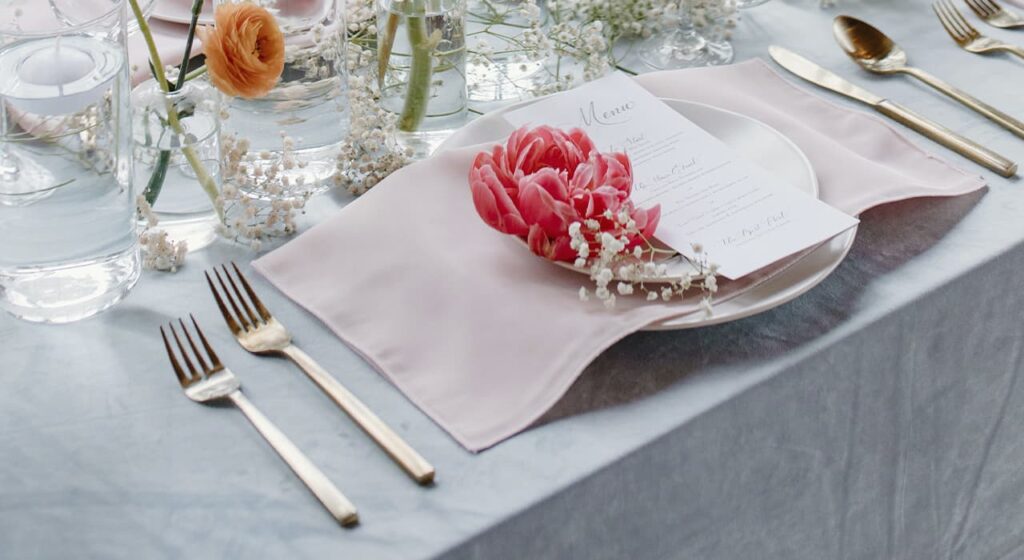The history of cutlery begins with the oldest cutlery, the knife. There is an opinion that it was the bone or stone knife, and not the stick, that was the first tool of skillful man. For many thousands of years the knife was used as a weapon, for hunting and all kinds of work, but already about 5000 years ago there appeared special table knives. Up until the Middle Ages, people carried personal all-purpose knives, which were used not only at the table, but also at work. In the 15th and 16th centuries, expensive knives made of gold with cuttings made of expensive wood appeared on the tables of the nobles. Over time, only the materials in knives changed, new forms of the blade and handle appeared. Simple bronze knives with wooden handles and refined silver and gold knives with luxurious inlaid handles gave way to versatile steel knives with plastic handles. As for the shape of the knife, the first table knives made of copper and bronze differ only slightly in shape from modern knives. Until the 17th century, there were only knives with pointed blades. Rounded blade bases, according to legend, appeared by order of Louis XIV in order to prevent the habit of courtiers picking their teeth and eating from the knife. Although the folding knife seems to be a recent invention, it was invented by the Romans back in the first century for use during military campaigns and travels. Appeared soon a custom to carry a knife in a sheath prevented further development of pocket knives. At the end of 16th century folding knife again became necessary for travelers and soldiers as a weapon, defense tool and cutlery.
The second cutlery after the knife was the spoon. It is not known exactly when the first spoons appeared, because they were made of clay, wood chips, nutshells or shells. Until now, in remote parts of the world people use shells for scooping liquid food, and in Latin and Greek the word “spoon” is formed from “snail shell. As early as the 3rd millennium B.C. spoons made of horn, wood and fish bones appeared. The Roman nobility already used gold spoons. In Egypt, the spoons for the nobility were made of precious metals, ivory and stone, the commoners used wooden spoons, and often ate with their hands. In Southeast Asia, beautiful spoons were made of crystals and later porcelain. In Europe, mostly wooden spoons were made. The Anglo-Saxon word for “spoon” has the same root as “chip”. The history of cutlery in Russia shows that the spoon entered the life of common people much earlier than in Europe. It was customary to carry their own wooden spoon with them to visit until the 19th century. There were many variations of wooden spoons from coarse rough spoons to thin and carved pointed ones. The first mention of silver spoons in Russia dates back to 988, when Vladimir the Red Sun’s cohorts demanded large silver spoons as compensation for accepting the new faith.
History of CutleryAlthough the Romans, who spread cutlery throughout the Roman Empire, preferred spoons of oval shape with a long handle, in Europe spoons with a round notch and a short handle convenient for gripping spread, and only in the 15-17 centuries elongated spoons of oval shape began to appear again. Significant lengthening of the handle occurred at a time when bouffant collars and jabots were in fashion. With the advent of wigs and crinolines, the handles of spoons took on an elegant form and length that we are familiar with. In the middle of the 19th century there were spoons with flat handles, because they could be elegantly held with three fingers. At the same time, the custom of placing figurines of the 12 apostles on the handles of expensive spoons appeared. (This is why sets were formed for 12 people.) The infant was given a silver spoon with the image of the apostle after whom he was named at his christening. To this day, this custom has survived in many Christian countries.
Cutlery became a work of art a long time ago, as the history of cutlery tells us. “Silverware” was a symbol of aristocracy and distinguished commoners from the nobility not only by the presence of luxury items, but also by the ability to use cutlery and observe etiquette. An old English magazine gives the following advice: make a hole in a silver teaspoon in order to accustom a child to use it only for stirring sugar and picking up teaspoons, and not for drinking tea or pouring sugar.
